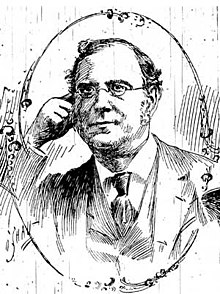Marc Delafontaine
Marc Delafontaine | |
|---|---|
 | |
| Born | March 31, 1837 or 1838 |
| Nationality | Swiss |
| Known for | holmium |
| Scientific career | |
| Institutions | University of Geneva |
Marc Delafontaine (March 31, 1837/1838, Céligny, Switzerland[a]–1911[b]) was a Swiss chemist and spectroscopist who was involved in discovering and investigating some of the rare earth elements.
Career
[edit]Delafontaine studied with Jean Charles Galissard de Marignac at the University of Geneva. He also worked at the University of Geneva.[1]
Delafontaine moved to the United States of America, arriving in New York in 1870,[2] and later becoming a naturalized citizen.[1] He taught in Chicago, Illinois at city high schools,[2] and at a women's college.[1] He also worked as an analytical chemist with the Chicago Police Department.[2]
Research
[edit]Holmium
[edit]In 1878, along with Jacques-Louis Soret, Delafontaine first observed holmium spectroscopically.[3] In 1879, Per Teodor Cleve chemically separated it from thulium and erbium. All three men are given credit for the element's discovery.[1]
Yttrium, terbium and erbium
[edit]In 1843, Carl Gustaf Mosander discovered terbium and erbium as components of yttria.[4]: 38 [2]: 701 [5][6] [7] However, this discovery was hotly contested. Spectroscopist Nils Johan Berlin denied that the two elements existed, failing to confirm the existence of "erbia" and suggesting that its name be applied to "terbia".[8]
In 1864, Marc Delafontaine used optical spectroscopy to conclusively prove that yttrium, terbium, and erbium were separate elements.[8] Ironically, however, the confusion that had been introduced between the names continued. Mosander's proposed names were switched, giving the amethyst compound the name "erbium" oxide and the yellow substance the name "terbium" oxide, instead of the other way around as originally proposed.[9][10][7][8]
References
[edit]- ^ a b c d Fontani, Marco; Costa, Mariagrazia; Orna, Mary Virginia (2014). The Lost Elements: The Periodic Table's Shadow Side. Oxford University Press. pp. 119–125. ISBN 9780199383344.
- ^ a b c d Weeks, Mary Elvira (1956). The discovery of the elements (6th ed.). Easton, PA: Journal of Chemical Education.
- ^ Thornton, Brett F.; Burdette, Shawn C. (20 May 2015). "Homely holmium". Nature Chemistry. 7 (6): 532. Bibcode:2015NatCh...7..532T. doi:10.1038/nchem.2264. PMID 25991534.
- ^ Tansjö, Levi (December 6, 2012). "Carl Gustaf Mosander and His Research on Rare Earths". In Evans, C. H. (ed.). Episodes from the History of the Rare Earth Elements. Springer Science & Business Media. pp. 38–55. ISBN 9789400902879.
- ^ Weeks, Mary Elvira (1932). "The discovery of the elements: XVI. The rare earth elements". Journal of Chemical Education. 9 (10): 1751–1773. Bibcode:1932JChEd...9.1751W. doi:10.1021/ed009p1751.
- ^ Marshall, James L.; Marshall, Virginia R. (October 31, 2014). "Northern Scandinavia: An Elemental Treasure Trove". Science history : a traveler's guide. Vol. 1179. ACS Symposium Series. pp. 209–257. doi:10.1021/bk-2014-1179.ch011. ISBN 9780841230200.
- ^ a b Piguet, Claude (21 March 2014). "Extricating erbium". Nature Chemistry. 6 (4): 370. Bibcode:2014NatCh...6..370P. doi:10.1038/nchem.1908. PMID 24651207.
- ^ a b c Friend, John Newton (1917). A Text-book of Inorganic Chemistry. Vol. 4. Griffin & Company. pp. 221–223. ISBN 9781130017649.
- ^ Holden, Norman E. (2001-06-29). "History of the Origin of the Chemical Elements and Their Discoverers". Upton, New York: Brookhaven National Laboratory (BNL).
{{cite journal}}: Cite journal requires|journal=(help) - ^ Krishnamurthy, Nagaiyar (December 16, 2015). Extractive metallurgy of rare earths (2nd ed.). CRC Press. pp. 5–7. ISBN 9781466576346.
Notes
[edit]- ^ Fontani op. cit. p. 125 states that Poggendorff's Biographisch-Literarisches Handwörterbuch, Verlag von Johan Ambrosius Barth, Leipzig, 1898, p. 344 gives his birthyear as 1838, while Mary Elvira Weeks Discovery of the Elements, 7. ed., Journal of Chemical Education: Easton, Pennsylvania, 1968, p. 677 says it is 1837.
- ^ Fontani op. cit. p. 125 says that no documents exist to report his death but it is assumed Delafontaine passed away in 1911.
